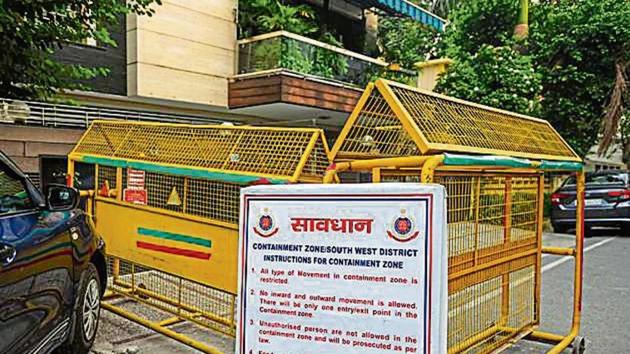Red zone count hits 2k, over 16% in S-W district
Of the 2,059 containment zones, most are concentrated in the western part of the city, with the highest number in the southwest district, which has 341 restricted areas (16.6%), followed by the west (234), and northwest (229) districts.
The number of containment zones in Delhi crossed the 2,000-mark on Thursday, according to government data, even as the national capital added 3,834 cases of the coronavirus disease.

Of the 2,059 containment zones, most are concentrated in the western part of the city, with the highest number in the southwest district, which has 341 restricted areas (16.6%), followed by the west (234), and northwest (229) districts.
With 72, northeast district has the fewest such zones (less than 4%) of the city’s 11 revenue districts, the data showed.

The city had 1,987 containment zones as on Wednesday. The hot spots crossed the 1,500-mark on September 14, and over 50 such zones have been demarcated in the city on average every day since then.
At least 10 of these zones have been sealed for more than two months now, officials said, including hot spots in Rohini Sector 1, RPS colony in Khanpur, an apartment in Dwarka’s Sector 16B, Valmiki Basti in Jhatikara village, Lohia Mohalla in Shikarpur and five separate areas in Dakshinpuri locality.
The data showed that the localities that have the highest number of containment zones include Rohini (with 58 containment zones spread largely across sectors 3, 8, 14, 15, 16, 18 and 21), Pitampura (30), Uttam Nagar (11), Dwarka (with 40 containment zones spread largely across sectors 4, 7, 8, 12, 13, 14, 16 and 23) and Paschim Vihar (24).
Around 19% of the city’s total active Covid-19 cases are located within containment zones, showed a report published by HT on Monday.
Containment zones are sealed areas where free movement of individuals and traffic is prohibited, so are economic activities. All residents are put under strict surveillance, are periodically screened and the area is sanitised.
These areas are subject to these curbs for at least 21 days from the date the last new case was recorded.
The Capital had 31,125 active cases of the infection as on Thursday, and 5,123 have died so far. The city has seen a surge in cases since the first week of September, with over 3,700 infections added on average daily over each of the past seven days.
“Quickly identifying containment zones has helped Delhi arrest the spread of the coronavirus disease significantly,” chief minister Arvind Kejriwal said on Thursday, on the sidelines of his visit to the Indian Agriculture Research Institute for the live demonstration of a crop stubble decomposition technology.
Delhi’s revenue minister Kailash Gahlot on Thursday told HT, “The government is aggressively creating containment zones to break the chain of transmission at the earliest. However, it is important to mention that the focus of the government is on creating smaller containment zones so that lesser people are affected. The status of the containment zones is periodically reviewed.”
Delhi lieutenant governor (L-G) Anil Baijal had last week issued directions to the city administration to re-draft its strategy on containment zones. The new strategy, however, is yet to be finalised, said senior officials in the revenue department.
This is the second time that Delhi’s containment zone strategy will be re-drafted. It was first re-drafted on June 26, in adherence to recommendations of Union home minister Amit Shah, following which the number of containment zones had shot up from 280 to 440 over three days.
HT’s September 19 report, based on data till September 16, showed how the northwest and southwest revenue districts in Delhi – which rank among the top three in terms of number of containment zones — also account for the highest share of active covid-19 cases — 16.3% and 13.3% respectively. These districts have a mix of planned residential areas (such as Rohini and Dwarka sub-cities) and densely populated unplanned areas including unauthorised colonies, villages and slum clusters.
Lalit Kant, former head of the department of epidemiology at the Indian Council of Medical Research (ICMR), said, “Delhi has adopted the right approach. Timely demarcation of containment zones and increased surveillance are helpful strategies in arresting the spread of covid-19. Delhi should continue with its containment efforts.”
However, Jugal Kishore, head of the community medicines department in Safdarjung Hospital, said: “At this point, Delhi can also consider doing away with the concept of containment zones and increase the scale of contact tracing and surveillance for each and every Covid-19 case identified.”
Stay updated with all top Cities including, Bengaluru, Delhi, Mumbai and more across India. Stay informed on the latest happenings in World News along with Delhi Election 2025 and Delhi Election Result 2025 Live, New Delhi Election Result Live, Kalkaji Election Result Live at Hindustan Times.
Stay updated with all top Cities including, Bengaluru, Delhi, Mumbai and more across India. Stay informed on the latest happenings in World News along with Delhi Election 2025 and Delhi Election Result 2025 Live, New Delhi Election Result Live, Kalkaji Election Result Live at Hindustan Times.






